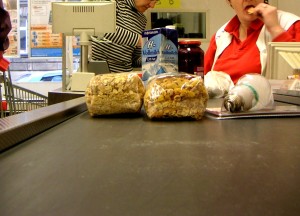I’m sitting at the NoroCORE annual meeting and listening to Aron Hall and others talk about sources of noro illnesses. Stuff like ill food handlers and bare hand contact in full service restaurants rise to the top as risk factors for the most prevalent food-related pathogens. Dirty conveyor belts, not so much.
Tove Danovich of Food Politic interviewed me a couple of weeks ago about issues related to conveyor belts in grocery stores wondering whether they a good source for illnesses?
I told her that when it comes to outbreaks and pathogens, I’m not sure the data is there.
If you’re squeamish about the thought of unseen bacterium and pathogens, stop reading. A 2009 study found contamination on 100% of tested grocery store conveyor belts. Though they often seem clean, a lack of dust doesn’t mean they aren’t a breeding ground for bacteria. The question to ask ourselves us is whether these grocery store workhorses have the potential to make us sick.
The study, conducted by Dr. Zhinong Yan, took 100 samples from 42 grocery stores in Michigan. They were tested for “total aerobic bacteria count (TAC), yeast, mold, Staphylococcus aureus (Staph), and coliforms.” Coliforms are a rod-shaped bacteria that are commonly used as bacterial indicators due to their easy cultivation and large presence in fecal matter. If you’ve got coliforms, you’ve got stool (this is not true, the bacteria that make up the coliform group are naturally associated with lots of plants, without poop – ben). Dr. Yan also tested for more dangerous bacteria like MRSA, E. coli, salmonella, and listeria. Luckily, evidence of the most dangerous foodborne pathogens weren’t found.
What was detected, however, were high levels of just about everything else – including coliform bacteria. These belts might not give you stomach flu but probably needed a good round of sanitation.
Enter the antimicrobial conveyor belt, a cover for your bacteria-covered black belts. Antimicrobial wraps both kill bacteria and are non-porous (read: can actually be cleaned). A somewhat ingenious advertisement from MessageWrap, an antimicrobial surface that can also display ads or other messages, shows that even a child can install it in under an hour.
Yet not everyone is sure that conveyor belts are breeding grounds for dangerous microbes. Benjamin Chapman, Food Safety Specialist, often works with consumers, grocery, and retail stores to curb potential risks. “When we look at conveyor belts, there are two components of risk: what’s the likelihood of pathogens being there and how they could be transferred to food,” he says. While he agrees that conveyor belts are difficult to clean and sanitize, that doesn’t automatically mean they should be a source of worry.
To put it simply, bacteria can be found in any environment – your bathroom, kitchen table, or cooking surfaces at home. Chapman has never found data to prove that conveyor belts are particularly good at transferring pathogens to food. Of course, that doesn’t mean you shouldn’t ask for the belt to be sanitized if the person in front of you has a package of chicken that’s leaking fluid. “If I see something, I’m going to do what I can do make it safer,” Chapman adds.
As for microbial wraps, they may not even get rid of potential contamination. As Chapman put it, “It’s not a magic bullet.” All conveyor belts have seams that are often particularly hard to sanitize and clean whether it’s a wrap or black PVC. If you’re going to find bacteria, that’s a good place to look.
So unless you’re shopping for groceries in a particularly dingy store, chances are good that you have little to worry about. “If there’s going to be food, there’s going to be bacteria,” Chapman says. We’d be sick forever if the mere presence of bacteria was enough to give us a foodborne illness.
Don’t avoid the grocery store just yet but be mindful of the state of the surfaces where you set your food. As for your mild case of bacterial OCD? Chapman may have put it best, “I’m not in the business of knowing how much people should be concerned about something.”
This last bit was in response to a question Tove asked “how concerned should people be?” My philosophy (stolen from many other smart people in the food safety risk analysis work) is that I want to present the risks and let people make their own risk management decisions. How concerned someone is (whether an individual or a food safety nerd at a food company) is a risk management calculation. It didn’t come out quite right.


 The story continues,
The story continues, I’ve been known to buy the odd slice of pizza or bucket of fried chicken from the ready-to-eat counter of grocery stores, often a result of shopping on an empty stomach. And truthfully, I’ve never thought much about how these food establishments were inspected, perhaps assuming they fell under the local health department’s umbrella, like most restaurants.
I’ve been known to buy the odd slice of pizza or bucket of fried chicken from the ready-to-eat counter of grocery stores, often a result of shopping on an empty stomach. And truthfully, I’ve never thought much about how these food establishments were inspected, perhaps assuming they fell under the local health department’s umbrella, like most restaurants. In Georgia restaurants are required to display an “A” “B” “C” or “U” (for unsatisfactory) letter grade and numerical score near the establishment entrance so that patrons can make an informed dining decision. This includes drive-thru windows and other take-out entrances; unfortunately, since grocery store ready-to-eat counters aren’t inspected by the same department as other food establishments, customers won’t see a letter grade at these counters.
In Georgia restaurants are required to display an “A” “B” “C” or “U” (for unsatisfactory) letter grade and numerical score near the establishment entrance so that patrons can make an informed dining decision. This includes drive-thru windows and other take-out entrances; unfortunately, since grocery store ready-to-eat counters aren’t inspected by the same department as other food establishments, customers won’t see a letter grade at these counters.
 Growing up, my brother
Growing up, my brother 
 My bother Jesse (currently a third grader) found a hero in Spiderman.
My bother Jesse (currently a third grader) found a hero in Spiderman.